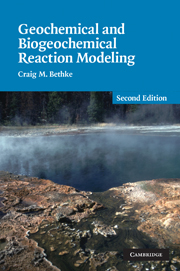Book contents
- Frontmatter
- Contents
- Preface
- Preface to first edition
- A note about software
- 1 Introduction
- 2 Modeling overview
- Part I Equilibrium in natural waters
- Part II Reaction processes
- 13 Mass transfer
- 14 Polythermal, fixed, and sliding paths
- 15 Geochemical buffers
- 16 Kinetics of dissolution and precipitation
- 17 Redox kinetics
- 18 Microbial kinetics
- 19 Stable isotopes
- 20 Transport in flowing groundwater
- 21 Reactive transport
- Part III Applied reaction modeling
- Appendix 1 Sources of modeling software
- Appendix 2 Evaluating the HMW activity model
- Appendix 3 Minerals in the LLNL database
- Appendix 4 Nonlinear rate laws
- References
- Index
19 - Stable isotopes
Published online by Cambridge University Press: 05 August 2012
- Frontmatter
- Contents
- Preface
- Preface to first edition
- A note about software
- 1 Introduction
- 2 Modeling overview
- Part I Equilibrium in natural waters
- Part II Reaction processes
- 13 Mass transfer
- 14 Polythermal, fixed, and sliding paths
- 15 Geochemical buffers
- 16 Kinetics of dissolution and precipitation
- 17 Redox kinetics
- 18 Microbial kinetics
- 19 Stable isotopes
- 20 Transport in flowing groundwater
- 21 Reactive transport
- Part III Applied reaction modeling
- Appendix 1 Sources of modeling software
- Appendix 2 Evaluating the HMW activity model
- Appendix 3 Minerals in the LLNL database
- Appendix 4 Nonlinear rate laws
- References
- Index
Summary
Stable isotopes serve as naturally occurring tracers that can provide much information about how chemical reactions proceed in nature, such as which reactants are consumed and at what temperature reactions occur. The stable isotopes of several of the lighter elements are sufficiently abundant and fractionate strongly enough to be of special usefulness. Foremost in importance are hydrogen, carbon, oxygen, and sulfur.
The strong conceptual link between stable isotopes and chemical reaction makes it possible to integrate isotope fractionation into reaction modeling, allowing us to predict not only the mineralogical and chemical consequences of a reaction process, but also the isotopic compositions of the reaction products. By tracing the distribution of isotopes in our calculations, we can better test our reaction models against observation and perhaps better understand how isotopes fractionate in nature.
Bowers and Taylor (1985) were the first to incorporate isotope fractionation into a reaction model. They used a modified version of eq3/eq6 (Wolery, 1979) to study the convection of hydrothermal fluids through the oceanic crust, along midocean ridges. Their calculation method is based on evaluating mass balance equations, as described in this chapter.
As originally derived, however, the mass balance model has an important (and well acknowledged) limitation: implicit in its formulation is the assumption that fluid and minerals in the modeled system remain in isotopic equilibrium over the reaction path. This assumption is equivalent to assuming that isotope exchange between fluid and minerals occurs rapidly enough to maintain equilibrium compositions.
We know, however, that isotope exchange in nature tends to be a slow process, especially at low temperature (e.g., O'Neil, 1987).
- Type
- Chapter
- Information
- Geochemical and Biogeochemical Reaction Modeling , pp. 269 - 284Publisher: Cambridge University PressPrint publication year: 2007



